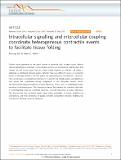| dc.contributor.author | Xie, Shicong | |
| dc.contributor.author | Martin, Adam C | |
| dc.date.accessioned | 2015-09-14T13:06:37Z | |
| dc.date.available | 2015-09-14T13:06:37Z | |
| dc.date.issued | 2015-05 | |
| dc.date.submitted | 2014-11 | |
| dc.identifier.issn | 2041-1723 | |
| dc.identifier.uri | http://hdl.handle.net/1721.1/98473 | |
| dc.description.abstract | Cellular forces generated in the apical domain of epithelial cells reshape tissues. Recent studies highlighted an important role for dynamic actomyosin contractions, called pulses, that change cell and tissue shape. Net cell shape change depends on whether cell shape is stabilized, or ratcheted, between pulses. Whether there are different classes of contractile pulses in wild-type embryos and how pulses are spatiotemporally coordinated is unknown. Here we develop a computational framework to identify and classify pulses and determine how pulses are coordinated during invagination of the Drosophila ventral furrow. We demonstrate biased transitions in pulse behaviour, where weak or unratcheted pulses transition to ratcheted pulses. The transcription factor Twist directs this transition, with cells in Twist-depleted embryos exhibiting abnormal reversed transitions in pulse behaviour. We demonstrate that ratcheted pulses have higher probability of having neighbouring contractions, and that ratcheting of pulses prevents competition between neighbouring contractions, allowing collective behaviour. | en_US |
| dc.description.sponsorship | National Institute of General Medical Sciences (U.S.) (Grant R00GM089826) | en_US |
| dc.description.sponsorship | National Institute of General Medical Sciences (U.S.) (Grant R01GM105984) | en_US |
| dc.language.iso | en_US | |
| dc.publisher | Nature Publishing Group | en_US |
| dc.relation.isversionof | http://dx.doi.org/10.1038/ncomms8161 | en_US |
| dc.rights | Creative Commons Attribution | en_US |
| dc.rights.uri | http://creativecommons.org/licenses/by/4.0/ | en_US |
| dc.source | Nature Publishing Group | en_US |
| dc.title | Intracellular signalling and intercellular coupling coordinate heterogeneous contractile events to facilitate tissue folding | en_US |
| dc.type | Article | en_US |
| dc.identifier.citation | Xie, Shicong, and Adam C. Martin. “Intracellular Signalling and Intercellular Coupling Coordinate Heterogeneous Contractile Events to Facilitate Tissue Folding.” Nat Comms 6 (May 26, 2015): 7161. © 2015 Macmillan Publishers Limited | en_US |
| dc.contributor.department | Massachusetts Institute of Technology. Computational and Systems Biology Program | en_US |
| dc.contributor.department | Massachusetts Institute of Technology. Department of Biology | en_US |
| dc.contributor.mitauthor | Xie, Shicong | en_US |
| dc.contributor.mitauthor | Martin, Adam C. | en_US |
| dc.relation.journal | Nature Communications | en_US |
| dc.eprint.version | Final published version | en_US |
| dc.type.uri | http://purl.org/eprint/type/JournalArticle | en_US |
| eprint.status | http://purl.org/eprint/status/PeerReviewed | en_US |
| dspace.orderedauthors | Xie, Shicong; Martin, Adam C. | en_US |
| dc.identifier.orcid | https://orcid.org/0000-0001-8060-2607 | |
| dc.identifier.orcid | https://orcid.org/0000-0002-3283-3248 | |
| mit.license | PUBLISHER_CC | en_US |
| mit.metadata.status | Complete | |
